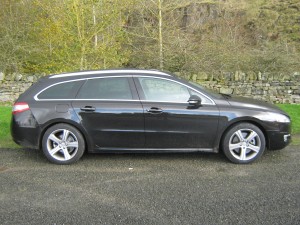Station Wagon n. another name (less common in Britain) for estate car.
From the tourists’ perspective, the Gauls have a sense of nationalism judging by the lack of English subtitles on French television that may emanate from the turbulent history between these two countries which might account for that continental acronym. ‘SW’ labels the tailgate of the Peugeot 508. At least, Station Wagon has a clearer meaning than ‘Sports Tourer’ that Vauxhall adopted for the Insignia, yet they both have one characteristic as they are not true estates. Both have narrow loading areas facing you, once the tailgates are opened so that a washing machine will not fit standing unlike in a Skoda Superb estate. Volkswagen style latches flip the seatbacks over the squabs to form an uneven surface and the load cover doesn’t retract as fluidly as that in a Superb estate. The reason for reduction of the ‘estate’ class is that rooflines have generally become lower and less uniform to suit the customer clinics’ liking of driving a pseudo sports car. You appear to be sitting lower down with higher door skins and less glass area, not considering the standard panoramic sunroof for the top three trip levels. An array of names abound from Sportback to Shooting Brake with diluted meanings weaker than an orange cordial!

The 508 fills the void left by the deletion of the 407 and 607 that aren’t lamented in the UK. The former suffered, amongst other foibles from squealing brakes and poor ride with the latter being remembered by having one of the largest depreciation rates therefore a good purchase for the taxi trade in diesel form. Fortunately, the 508 marks a departure away from style over substance, unlike in my opinion, the RCZ despite what the mainstream motoring press heralded as “a renaissance” for Peugeot – blah blah blah. The fact is that the 508 SW has the potential to steal fleet sales away from established company car manufacturers, especially with the 1.6 HDi start stop. Furthermore, five trim levels include ‘SR’ that specifically targets the corporate and fleet sector with cruise control, air conditioning and Bluetooth connectivity.

Our test car was the top tier GT model with 2.2 HDi engine that has 204bhp – a leader in this class. For this specification, Peugeot added another wishbone to each front wheel, presumably to cope with the added mass from the engine and rear suspension is a multi-arm set up across the whole range – no sign of the archaic torsion beam! On tarmac, the 508 feels it so you know where you are at with the machine so bends are taken with poise and assurity translating to clear feedback via electro-hydraulic pump to the steering wheel.
Unfortunately, the six speed automatic is the only option with this engine with paddle shifts and Porsche tiptronic system being the only sign of frivolity, with every other component having a clear function; a massage seat back for that important lumbar area of the spine for driver is one worthy example. A head-up display projects out of the dashboard showing sat nav directions and speed readings, something I remember when testing a BMW 6 series. The mass of buttons covering every part of plastic could have been reduced by a similar i drive system a la BMW as cruise control buttons are relegated low down on the steering wheel outside the field of vision. A pull down cubby flap conceals even more controls for the head-up display with the indicator stalk hiding three buttons directly behind it from the driver’s view. Other ergonomic issues are cup holders that impede with the Sat Nav screen; postcodes were not accepted by the system either. Seating and plastics are similar to Germanic marques with plenty of legroom but that gently sloping roofline to create that revered sporting look does interfere with width especially when you have three adults in the back rubbing knees and shoulders. Solidly built, the only problem identified was warped plastic at one edge of the rear bumper where it joined the rear wing so the surface was uneven.
Once you have removed the superfluous plastic engine cover, you notice space for hands to work around the engine bay with the oil filter clearly visible. Furthermore, four diesel injectors attached to the common rail have more apetures to spray finer diesel, aiding combustion. A warning chime with seven litres to spare for the seventy two litre tank revealed that for sixty five litres of diesel burnt, a combined figure of 46.5mpg was achieved over 665 miles that tallied with Peugeot’s own figure of 47.8. Our journey up the M6 from Manchester to Grizedale in the Lake District ending in Malham, Yorkshire consisted of more undulating A and B roads than motorway with darkness preventing my most favourite of diesel test routes, that of the Hardknott and Wrynose passes.

This car has altered my perception of Peugeot as they have redressed the balance between engineering and form. More Passion than Station Wagon.
Words and photos by Sotiris Vassiliou
Film by Sotiris Vassiliou, Emily Doncaster and Peter Kemball.
January 2012




